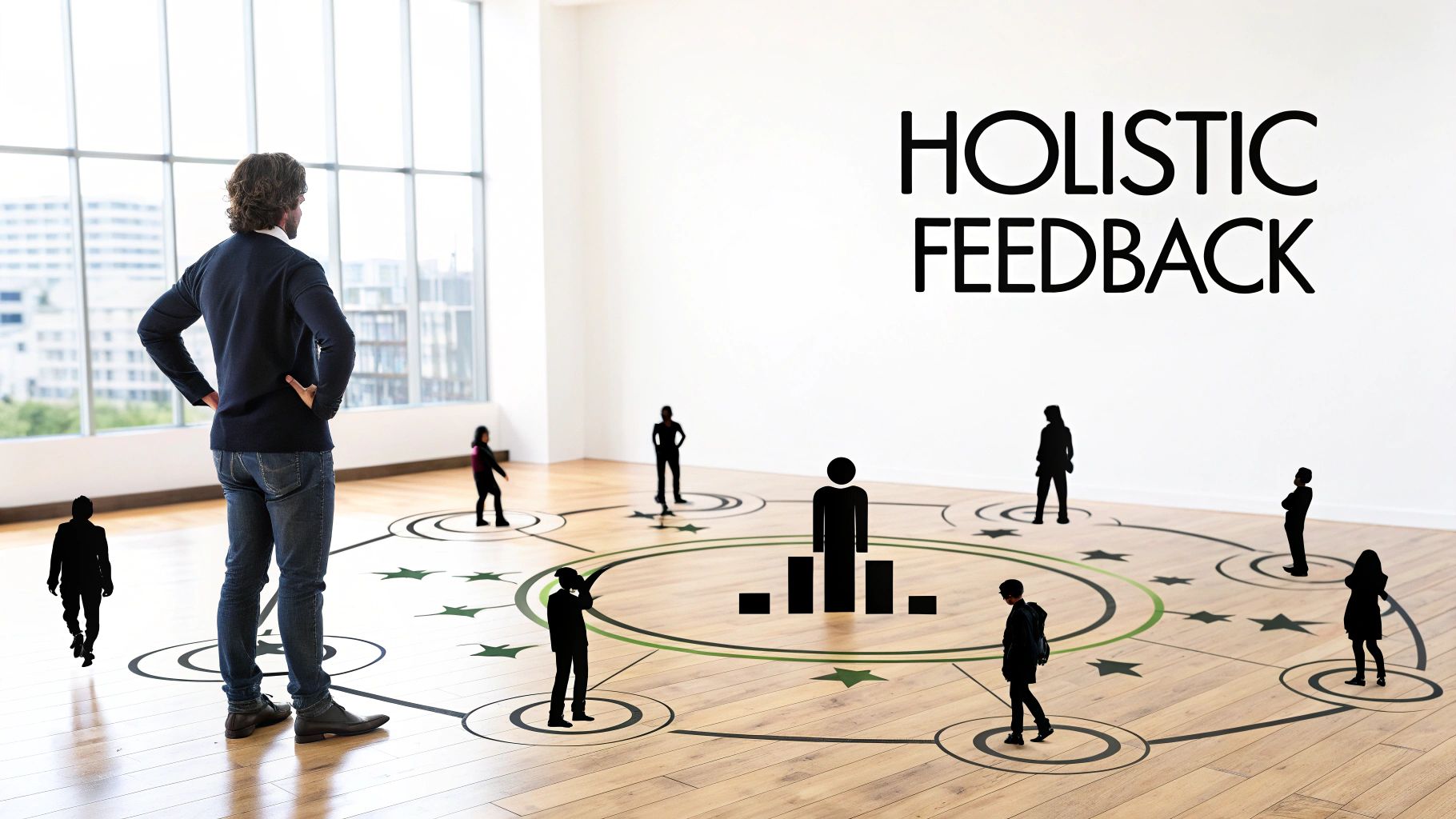Level Up Your Performance Reviews
Performance reviews are key to employee growth and development. Effective reviews boost morale, pinpoint improvement areas, and align individual goals with company objectives. This listicle explores eight diverse performance review examples, from continuous feedback to project-based assessments. Whether you're an HR professional seeking certification or a manager aiming to enhance team performance, these examples provide practical strategies for more effective and meaningful reviews. Learn how to transform your reviews into powerful tools for growth.
1. 360-Degree Feedback Performance Review
The 360-degree feedback performance review is a powerful tool for gaining a holistic understanding of an employee's performance. It moves beyond the traditional top-down review by gathering input from multiple perspectives: managers, peers, direct reports, and sometimes even customers. This comprehensive approach paints a much richer picture of an individual's strengths, areas for development, and overall contribution to the team and organization. By incorporating diverse viewpoints, the 360-degree review helps individuals gain valuable self-awareness and identify blind spots they might not otherwise recognize, empowering them to unlock their full potential.

This method typically employs standardized, competency-based questions, often administered anonymously to encourage honest and open feedback. The process usually occurs annually or semi-annually and can also include a self-assessment component, allowing individuals to reflect on their own performance and compare their perceptions with the feedback received from others. This multi-faceted approach makes the 360-degree review a truly valuable tool for fostering growth and development.
Why This Method Deserves Its Place in the List: The 360-degree feedback review offers a level of depth and insight unmatched by traditional methods. It directly addresses the limitations of single-source reviews, which can be prone to bias and may not capture the full scope of an employee's impact. Its emphasis on multi-source feedback promotes a culture of transparency, accountability, and continuous improvement within the organization.
Features and Benefits:
- Multi-Stakeholder Input: Collects feedback from a diverse range of individuals who interact with the employee, offering a well-rounded perspective.
- Anonymity: Encourages honest and candid feedback without fear of reprisal.
- Standardized Questions: Ensures consistency and facilitates meaningful comparisons.
- Self-Assessment: Promotes self-reflection and enhances self-awareness.
- Enhanced Development: Provides specific, actionable feedback for targeted growth and improvement.
Pros and Cons:
Pros:
- Reduces Bias: Incorporating multiple perspectives mitigates the impact of individual biases.
- Identifies Blind Spots: Uncovers areas for development that might be missed in traditional reviews.
- Promotes Team Accountability: Encourages collaboration and mutual support within teams.
- Richer Feedback: Provides a more comprehensive understanding of performance and behaviors.
- Enhances Self-Awareness: Facilitates personal growth and professional development.
Cons:
- Resource Intensive: Requires significant time and resources to implement effectively.
- Conflicting Feedback: Can generate differing opinions that require careful interpretation.
- Potential for Anxiety: May cause stress if not managed sensitively and transparently.
- Requires Trust: Demands a culture of trust and psychological safety for optimal results.
- Administrative Complexity: Can be challenging to manage without dedicated software.
Successful Implementations:
- Google (gDevelopment): Utilizes peer and manager feedback for a comprehensive performance overview.
- Deloitte: Implements 360-degree reviews for its consulting professionals.
- Microsoft: Incorporates peer feedback within its performance management system.
- Adobe (Check-in): Integrates 360-degree feedback into its continuous feedback process.
Actionable Tips for Implementation:
- Limit Reviewers: Keep the number of reviewers to 6-10 per employee to avoid feedback fatigue.
- Provide Training: Offer clear guidelines and training on providing constructive feedback.
- Focus on Behaviors: Encourage reviewers to focus on specific observable behaviors rather than personality traits.
- Actionable Feedback: Ensure feedback is actionable and geared towards development and improvement.
- Utilize Software: Leverage specialized software to streamline the collection and analysis process.
When and Why to Use This Approach:
The 360-degree feedback review is particularly valuable when seeking to:
- Develop High-Potential Employees: Provides targeted insights for accelerating leadership development.
- Improve Team Dynamics: Enhances communication and collaboration within teams.
- Foster a Culture of Feedback: Normalizes feedback and encourages ongoing growth.
- Gain a Holistic View of Performance: Offers a more complete understanding of individual contributions.
By embracing the 360-degree feedback process, organizations can cultivate a culture of continuous improvement, empower employees to reach their full potential, and drive sustained success. This approach represents a powerful investment in the growth and development of both individuals and the organization as a whole.
2. SMART Goals-Based Performance Review
The SMART Goals-Based Performance Review is a powerful, objective-driven approach to evaluating employee performance. It shifts the focus from subjective opinions to concrete achievements by measuring progress against pre-established goals. These goals are not arbitrary; they follow the SMART criteria – Specific, Measurable, Achievable, Relevant, and Time-bound. This framework provides a clear roadmap for both employees and managers, fostering a shared understanding of expectations and desired outcomes. By anchoring evaluations in quantifiable results, this method promotes transparency and fairness, ultimately contributing to a more motivated and high-performing workforce.

This method deserves its place on this list because it represents a cornerstone of modern performance management. It offers a structured, results-oriented approach that resonates with today's data-driven business environment. The focus on measurable outcomes enables clear tracking of progress and provides concrete evidence for compensation and promotion decisions.
Features and Benefits:
- Evaluates performance based on pre-defined SMART objectives: This eliminates guesswork and provides a clear understanding of what success looks like.
- Includes numerical or binary (achieved/not achieved) ratings: Offers quantifiable data for performance tracking and analysis.
- Often ties directly to compensation or promotion decisions: Provides a transparent link between performance and rewards.
- Typically includes goal-setting at the beginning of the review period: Encourages employee involvement and fosters ownership of goals.
- May incorporate weights for different goals based on priority: Allows for differentiation between critical and less critical objectives.
Pros:
- Provides clear expectations and reduces ambiguity: Everyone understands what needs to be accomplished.
- Creates objective criteria for evaluation: Reduces bias and promotes fairness.
- Aligns individual performance with organizational objectives: Connects individual contributions to the bigger picture.
- Facilitates easier tracking of progress throughout the year: Enables proactive course correction and ongoing feedback.
- Can be motivating when goals are challenging but achievable: Encourages employees to stretch themselves and reach their full potential.
Cons:
- May encourage focusing only on measured goals while neglecting other important aspects: It's important to balance quantifiable goals with qualitative contributions.
- Can become outdated if business priorities shift during the review period: Requires flexibility to adjust goals as needed.
- Sometimes leads to setting easily achievable goals to ensure success: Managers need to encourage ambitious yet realistic goal setting.
- May not capture qualitative aspects of performance like teamwork or innovation: Consider incorporating supplementary evaluation methods to address these areas.
- Can create unhealthy competition in collaborative environments: Emphasize teamwork and shared success even within a goal-oriented framework.
Examples of Successful Implementation:
- Intel: Uses the "Objectives and Key Results" (OKR) framework, a well-known example of SMART principles in action.
- Amazon: Employs goals-based performance management tied to their leadership principles.
- Salesforce: Integrates SMART goal tracking into their performance review system.
- Procter & Gamble: Leverages goals-based performance management for executives.
Actionable Tips for Implementation:
- Review and adjust goals quarterly: Ensure goals remain relevant and aligned with evolving business priorities.
- Include both performance goals (what to achieve) and development goals (how to grow): Support both performance outcomes and professional development.
- Ensure alignment between individual, team, and organizational objectives: Connect individual contributions to the overall success of the organization.
- Document goal progress throughout the year, not just at review time: Facilitate ongoing feedback and proactive adjustments.
- Consider using OKR software to track and manage goals systematically: Leverage technology to streamline the process.
When and Why to Use This Approach:
The SMART Goals-Based Performance Review is particularly effective in organizations that prioritize data-driven decision-making and value transparency. It's ideal for roles where performance can be readily quantified, such as sales, marketing, and engineering. This approach is also highly beneficial when aiming to foster a culture of accountability and continuous improvement. By focusing on clear, measurable goals, organizations can empower their employees to achieve exceptional results and drive organizational success.
3. Continuous Feedback Performance Model
The Continuous Feedback Performance Model represents a significant shift from traditional annual performance reviews. Instead of relying on retrospective evaluations, this dynamic approach fosters ongoing dialogue, coaching, and real-time feedback between managers and employees. It's about nurturing growth and addressing performance concerns as they arise, rather than letting them fester for months before being discussed. This creates a culture of continuous improvement, empowering employees to reach their full potential while fostering a stronger, more trusting relationship with their managers. It's a proactive model built for today's dynamic work environment.

This model typically involves regular one-on-one meetings – weekly, bi-weekly, or monthly – focusing on current projects, immediate development needs, and open two-way communication. It's not about top-down assessment but rather a collaborative conversation. Digital tools are often employed to capture feedback instantly, creating a valuable record of progress and areas for improvement. While some organizations retain a periodic formal review, its purpose shifts to summarizing ongoing progress and confirming shared understanding, minimizing surprises. This continuous feedback loop keeps performance discussions alive and relevant, driving constant growth.
This model deserves a prominent place in any performance review discussion because it embodies the future of performance management. Its focus on growth, development, and real-time feedback creates a more agile and responsive approach to performance, significantly benefiting both individuals and the organization as a whole.
Successful Implementations: Several leading companies have embraced continuous feedback with impressive results. Adobe's "Check-in" system famously eliminated annual reviews altogether, replacing them with ongoing conversations. Microsoft's "Connect" approach similarly emphasizes regular feedback and coaching. Accenture and GE (post-Jack Welch) have also transitioned to continuous feedback models, demonstrating the broad applicability of this approach across various industries.
Actionable Tips for Implementation:
- Create Structure: Establish a consistent format for check-in meetings to ensure they are productive and focused. A defined agenda can help guide the conversation.
- Train Managers: Equip managers with effective coaching and feedback skills. This is crucial for ensuring the quality and impact of the feedback provided.
- Leverage Technology: Utilize a simple, user-friendly digital system to document key takeaways, track progress, and facilitate ongoing communication.
- Balanced Feedback: Emphasize positive reinforcement alongside constructive criticism to create a motivating and supportive environment.
- Separate Development from Compensation: Decouple development conversations from compensation discussions to foster a growth mindset and avoid mixing messages.
When and Why to Use This Approach: The Continuous Feedback Performance Model is particularly well-suited for fast-paced environments with evolving priorities. It thrives in organizations that value employee engagement, transparency, and continuous improvement. It’s ideal for teams that embrace agile methodologies and require rapid adaptation. However, organizations considering this model should be prepared to invest significant management time and ensure appropriate training is provided.
Pros:
- Addresses performance issues promptly.
- Strengthens manager-employee relationships.
- Reduces recency bias.
- Adapts well to dynamic environments.
- Improves employee engagement.
Cons:
- Demands substantial manager time.
- Can be challenging to document consistently.
- Requires structured implementation.
- Depends on effective manager communication.
- Scaling in large organizations can be complex.
The Continuous Feedback Performance Model offers a powerful alternative to traditional performance reviews. By fostering ongoing dialogue, coaching, and real-time feedback, it creates a more engaged, responsive, and ultimately, more successful workforce. This model represents a fundamental shift towards a more human-centric approach to performance management, focusing on growth, development, and empowering individuals to achieve their fullest potential.
4. Competency-Based Performance Review
Elevate your performance management process with the power of Competency-Based Performance Reviews! This structured and insightful approach shifts the focus from simply evaluating past performance to assessing the skills, behaviors, and attributes that drive success in specific roles. By establishing a clear framework of essential competencies, you can unlock a world of benefits for both your employees and your organization.
How it Works:
Competency-based reviews utilize predefined competency models, essentially blueprints for success in different roles. These models outline the key skills, knowledge, and behaviors required for optimal performance. Employees are then evaluated against these competencies using rating scales (e.g., 1-5 or novice to expert), providing a clear and consistent measure of proficiency. These competencies can encompass both technical skills (like coding proficiency for a software engineer) and behavioral attributes (like leadership skills for a manager).
Features that Fuel Success:
- Clearly Defined Competency Models: Provides a standardized framework for evaluation.
- Rating Scales: Enables objective assessment of proficiency levels.
- Technical and Behavioral Competencies: Offers a holistic view of employee capabilities.
- Industry/Role-Specific Standards: Aligns evaluations with industry best practices.
- Career Progression Frameworks: Connects performance to career growth opportunities.
Examples of Excellence:
Industry giants have embraced competency-based reviews with remarkable results. McKinsey & Company ties its evaluations to consulting excellence, while Johnson & Johnson leverages a leadership competency model across management levels. Even U.S. Government agencies utilize competency frameworks like the OPM Executive Core Qualifications. These examples showcase the adaptability and effectiveness of this approach across diverse sectors.
Why Choose a Competency-Based Approach?
This method brings clarity and consistency to performance evaluations. It answers the critical questions of what constitutes success in a specific role and how that success is measured. This transparency empowers employees to understand expectations, identify areas for growth, and chart a clear path for career advancement. For organizations, it facilitates talent management, succession planning, and targeted training initiatives.
Pros:
- Consistency: Ensures fair and equitable evaluations across teams and departments.
- Clarity: Defines clear expectations for different roles and levels.
- Career Development: Supports structured growth and advancement.
- Reduced Bias: Focuses on observable behaviors, minimizing subjectivity.
- Skill Gap Identification: Pinpoints areas for training and development.
Cons:
- Bureaucracy: Can become cumbersome with excessive competencies.
- Limited Scope: May not capture unique contributions outside the framework.
- Initial Investment: Requires dedicated resources to develop competency models.
- Impersonal: Can feel detached if not balanced with personalized feedback.
- Maintenance: Needs regular updates to reflect evolving job requirements.
Actionable Tips for Implementation:
- Keep it Concise: Limit competencies to 6-10 key areas.
- Illustrate with Examples: Provide specific behavioral examples for each competency level.
- Customize for Context: Adapt competencies for different departments or job families.
- Future-Proof Your Framework: Include competencies relevant to future organizational needs.
- Train Your Reviewers: Ensure consistent application of competency standards.
Inspired by Great Minds:
The roots of competency-based evaluations trace back to pioneering work by David McClelland, Richard Boyatzis (author of "The Competent Manager"), and the founders of Lominger International and Spencer & Spencer. These thought leaders paved the way for a more strategic and impactful approach to performance management.
Why It Deserves Its Place on the List:
The Competency-Based Performance Review stands as a cornerstone of modern performance management because it provides a structured, objective, and development-focused approach. By clarifying expectations, promoting fairness, and fostering continuous growth, it empowers both individuals and organizations to reach their full potential. This method isn't just about evaluating past performance; it's about building a future of success.
5. Behavioral Anchored Rating Scales (BARS) Performance Review
Elevate your performance reviews with the precision and clarity of Behavioral Anchored Rating Scales (BARS)! This sophisticated method represents a significant advancement in performance evaluation, combining the quantifiable nature of rating scales with the descriptive power of real-world behavioral examples. BARS empowers you to make more accurate and fair assessments, fostering a culture of growth and development within your organization.
Instead of relying on abstract traits, BARS anchors each point on a numerical scale with specific, observable behaviors directly related to the job. This allows reviewers to assess performance based on concrete actions, minimizing subjectivity and promoting a shared understanding of expectations. For example, instead of simply rating an employee as "good" in communication, a BARS system might describe a "good" communicator as someone who "actively listens to colleagues and clarifies information when needed."
How BARS Works:
BARS are typically developed through a process called critical incident analysis, where job experts and incumbents identify key behaviors that differentiate between excellent, average, and poor performance. These behaviors then become the "anchors" for the rating scale, usually ranging from 5-9 performance dimensions, each with 5-7 rating levels. This detailed approach provides a clear roadmap for employees to understand what constitutes success in their roles.
Examples of BARS in Action:
- Healthcare: A nurse's BARS might include behavioral anchors related to patient care, such as "effectively manages pain levels" or "communicates clearly with patients and families." Specific scenarios, like handling a patient emergency or providing emotional support, can be described for each rating level.
- Finance: Customer service representatives in a bank could be evaluated using BARS that focus on customer interaction. Anchors might include "resolves customer complaints efficiently" or "proactively offers additional services."
- Manufacturing: Production line supervisors can be assessed on behaviors related to safety, efficiency, and quality control. Anchors such as "maintains a safe working environment" or "identifies and resolves production bottlenecks" can be linked to specific observable actions.
- Retail: Sales associates' performance can be measured with BARS that highlight customer engagement, product knowledge, and sales techniques. Anchors like "builds rapport with customers" or "effectively explains product features and benefits" can be illustrated with specific examples.
Why BARS Deserves Its Place in Your HR Toolkit:
BARS stands out for its ability to reduce common rating errors, such as the halo effect, where a single positive impression influences the entire evaluation. By focusing on specific behaviors, BARS promotes more objective and defensible assessments. This not only improves the quality of performance feedback but also strengthens the legal defensibility of personnel decisions.
Pros:
- Reduces subjectivity and bias
- Provides clear performance standards
- Minimizes ambiguity
- Creates legally defensible documentation
- Helps employees understand expectations
Cons:
- Time-consuming to develop
- Requires frequent updates
- Can be cumbersome without proper software
- May not capture all aspects of complex jobs
- Requires cultural sensitivity during development
Actionable Tips for Implementing BARS:
- Involve the Experts: Engage job incumbents and subject matter experts in the development of behavioral anchors.
- Use Critical Incident Technique: Identify truly distinguishing behaviors that separate high performers from others.
- Keep it Current: Review and update the anchors annually to reflect evolving job requirements.
- Train Your Reviewers: Provide thorough training with practice cases to ensure consistent application.
- Supplement with Qualitative Feedback: Encourage reviewers to include open comments for behaviors not captured by the scales.
A Rich History:
Pioneered by organizational psychologists Patricia Smith and Lorne Kendall in the 1960s, and further developed by influential figures like Frank Landy and Gary Latham, BARS has become a cornerstone of effective performance management. The American Psychological Association's task force on performance appraisal also contributed significantly to its widespread adoption.
By embracing the BARS methodology, you're not just evaluating performance; you're cultivating a culture of clarity, fairness, and continuous improvement within your organization. Invest the time and effort in developing a robust BARS system, and you'll reap the rewards of a more engaged and productive workforce.
6. Narrative Performance Review (Essay Method)
The Narrative Performance Review, often referred to as the essay method, offers a refreshing departure from traditional, number-driven evaluations. It embraces the richness and complexity of human performance by focusing on detailed, qualitative descriptions of an employee's contributions, challenges, and growth. This approach prioritizes meaningful feedback and personalized development, creating a more engaging and impactful review experience.
Instead of relying on rigid rating scales, managers craft a narrative that captures the essence of an employee's performance. This story-like approach allows for a deeper exploration of context, specific examples, and even direct quotes from stakeholders, painting a comprehensive picture of the individual's contributions. This method is typically organized around key performance areas or guiding questions, providing a structure for the narrative while still allowing for flexibility and personalized insights.
Why This Method Deserves Its Place in the List:
In today's dynamic work environment, recognizing and nurturing individual talent requires more than just numbers. The Narrative Performance Review excels at capturing the nuances of performance, especially in roles that demand creativity, critical thinking, and complex problem-solving. It fosters a deeper understanding between managers and employees, paving the way for more effective coaching and development.
Features and Benefits:
- Rich, Detailed Feedback: Provides in-depth insights that go beyond surface-level assessments, capturing the "why" behind the "what" of performance.
- Personalized Development: Supports tailored growth plans based on specific strengths and areas for improvement, fostering a sense of ownership and motivation.
- Enhanced Communication: Creates a platform for open and honest dialogue between managers and employees, strengthening relationships and fostering trust.
- Contextualized Assessment: Considers the specific circumstances and challenges surrounding an individual's performance, offering a more fair and balanced evaluation.
- Meaningful Recognition: Celebrates unique contributions and achievements, boosting morale and reinforcing positive behaviors.
Pros and Cons:
Pros:
- Provides rich, detailed feedback that captures nuance.
- Allows for discussion of unique contributions not captured in standard forms.
- Creates a more personal and meaningful review experience.
- Accommodates discussion of complex situations and context.
- Better supports development planning through specific examples.
Cons:
- Highly dependent on the manager's writing skills and time investment.
- Difficult to compare across employees for compensation decisions.
- Can introduce more subjectivity and potential bias.
- Time-consuming to produce quality narratives.
- Challenging to analyze trends across the organization.
Examples of Successful Implementation:
Companies like Netflix, known for their innovative culture, have embraced written feedback without formal ratings. Many law firms, academic institutions, and creative agencies also utilize narrative reviews to assess performance in roles that require nuanced evaluation.
Actionable Tips for Implementation:
- Structure is Key: Provide a template with guiding questions to ensure comprehensive feedback.
- Ongoing Documentation: Encourage managers to collect notes throughout the review period, avoiding last-minute scrambling.
- Balanced Feedback: Utilize the "sandwich method" to deliver constructive criticism alongside positive reinforcement.
- Specificity Matters: Focus on concrete examples and avoid generalizations or personality judgments.
- Impact-Oriented: Emphasize outcomes and the impact of an employee's contributions.
When and Why to Use This Approach:
The Narrative Performance Review is particularly valuable in situations where:
- Qualitative aspects of performance are paramount: Roles involving creativity, innovation, and complex problem-solving.
- Individualized development is a priority: Fostering growth and maximizing individual potential.
- Building strong manager-employee relationships is crucial: Creating a culture of open communication and trust.
Popularized By:
The Narrative Performance Review has roots in the humanistic psychology movement, influenced by figures like Carl Rogers and Peter Block. Progressive educational institutions like Hampshire College and management thinkers like Daniel Pink have also championed this approach to feedback.
By embracing the Narrative Performance Review, organizations can move beyond simplistic evaluations and unlock the true potential of their workforce. This method empowers managers to become better coaches, fosters a more engaging review experience, and ultimately drives individual and organizational success.
7. Self-Assessment Performance Review: Unlock the Power of Reflection
Empower your employees and revolutionize your performance management process with the transformative power of self-assessment. This participatory approach invites employees to formally evaluate their own performance before their manager's review, fostering a sense of ownership and encouraging deep reflection on their contributions. It's a powerful tool for driving growth, enhancing communication, and building a culture of continuous improvement.
How it Works:
The self-assessment typically involves employees completing a structured form or answering a set of questions, often including self-ratings and concrete examples to support their evaluations. This process isn't about replacing the manager's review, but rather enriching it with valuable insights from the individual's perspective. Employees reflect on their achievements, challenges, strengths, weaknesses, and future development plans. This self-reflection prepares them for a more meaningful and productive conversation with their manager.
Successful Implementations:
Industry giants like IBM, Accenture, the Mayo Clinic, and Unilever have all incorporated self-assessment into their performance management processes, demonstrating its versatility and effectiveness across diverse sectors. IBM utilizes it within their formal performance management cycle, while Accenture leverages self-reflection as part of their continuous feedback model. Even healthcare professionals at the Mayo Clinic engage in self-assessment. These examples highlight the widespread adoption and proven benefits of this approach.
Actionable Tips for Implementation:
- Provide Crystal-Clear Guidelines: Equip your employees with clear instructions and illustrative examples to ensure they understand the process and can provide effective self-assessments.
- Focus on Specifics: Encourage employees to provide concrete examples rather than relying on general self-ratings. Ask them to describe specific situations and outcomes to illustrate their points.
- Promote Honesty and Growth: Demonstrate how the self-assessment will be used to inform their development, creating a safe space for honest reflection and encouraging open communication.
- Look Towards the Future: Include forward-looking questions about their career aspirations and growth plans, fostering a culture of continuous development and empowering them to take ownership of their future.
- Prepare for Meaningful Dialogue: Review self-assessments before the review meeting to identify potential discussion points, discrepancies, and opportunities for growth. This preparation ensures a more focused and productive conversation.
When and Why to Use Self-Assessment:
This method is particularly valuable when you aim to:
- Boost Employee Engagement: Actively involving employees in the process empowers them and increases their commitment to the outcomes.
- Foster Self-Reflection: Self-assessment encourages individuals to critically examine their performance and identify areas for improvement.
- Bridge Perception Gaps: It brings to light potential differences in perception between managers and employees, facilitating open dialogue and mutual understanding.
- Prepare for Productive Reviews: Self-assessment lays the groundwork for more meaningful and constructive performance review discussions.
- Uncover Hidden Achievements: Employees may highlight accomplishments that managers may have inadvertently overlooked.
Pros & Cons:
Pros: Increased engagement, promotes self-reflection, reveals perception gaps, prepares for productive conversations, highlights achievements.
Cons: Potential for self-rating biases, may create conflict if assessments differ significantly, quality depends on self-awareness, can be perfunctory if not taken seriously, may disadvantage employees from cultures that discourage self-promotion.
Thought Leaders & Inspiration:
The principles behind self-assessment are deeply rooted in the work of influential figures like Peter Senge, Chris Argyris, Marshall Goldsmith, and Martin Seligman. Their contributions to learning organizations, double-loop learning, feedforward, and positive psychology, respectively, have significantly shaped this approach.
Why Self-Assessment Deserves its Place on the List:
Self-assessment is an indispensable tool for any organization seeking to cultivate a culture of continuous improvement and empower its employees. By encouraging reflection, fostering open communication, and providing valuable insights, this method elevates the performance management process from a top-down evaluation to a collaborative journey of growth and development.
8. Project-Based Performance Review
Ditch the outdated annual review and embrace a dynamic approach to performance management: the Project-Based Performance Review. This innovative method shifts the focus from arbitrary timeframes to the concrete accomplishments achieved within specific projects. Imagine a system where feedback is timely, relevant, and directly tied to the work that matters most. That's the power of project-based reviews.
How it Works:
This approach centers on evaluating performance at key project milestones or upon completion. Instead of generic assessments, the emphasis is on individual contributions to project outcomes. Input is often gathered from various project stakeholders and team members, providing a holistic view of performance. Post-project retrospectives, a cornerstone of agile methodologies, become valuable opportunities for reflection and evaluation. This method can either supplement or entirely replace traditional time-based review cycles.
Why This Approach Deserves Its Place in the List:
In today's fast-paced, project-driven world, annual reviews can feel disconnected and irrelevant. Project-based reviews offer a refreshing alternative, aligning performance evaluations with the natural rhythm of work. This makes feedback more impactful and actionable, leading to continuous improvement and greater employee engagement. It's particularly effective for knowledge workers, creative professionals, and organizations operating within project-based structures.
Features and Benefits:
- Timely Feedback: Provides feedback when projects are complete and lessons are fresh in everyone's minds.
- Natural Alignment: Syncs with natural work cycles rather than arbitrary calendar dates.
- Concrete Focus: Concentrates on tangible deliverables and outcomes, making evaluations more objective.
- Contextualized Performance: Captures performance in different project contexts and team configurations.
- Agile Compatibility: Perfectly suited for agile work environments and matrix organizations.
Examples of Success:
- Pixar: Famous for its "postmortems" after each film, providing valuable performance feedback tied to the specific project.
- McKinsey: Evaluates consultants after each major client engagement, ensuring alignment with project goals and client satisfaction.
- Software Companies (Agile): Often integrate sprint retrospectives into performance data, fostering continuous improvement.
- Architectural Firms: Review individual contributions at project completion, ensuring recognition for specific achievements.
Pros and Cons:
Pros: Timely feedback, alignment with work cycles, focus on concrete outcomes, contextualized performance, agile compatibility.
Cons: Potential for inconsistent evaluation frequency, administrative challenges with multiple concurrent projects, difficulty standardizing for compensation reviews, potential to overlook ongoing responsibilities outside of projects, requires strong project management practices.
Actionable Tips for Implementation:
- Standardized Template: Develop a standardized yet flexible project review template to ensure consistency and efficiency.
- Minimum Frequency: Establish a minimum review frequency, regardless of project completion, to provide regular feedback.
- Multi-Stakeholder Feedback: Gather input from multiple project stakeholders for a well-rounded perspective.
- Contemporaneous Documentation: Document project contributions in real-time rather than relying on memory later.
- Holistic Integration: Combine project-based feedback with periodic holistic reviews for a comprehensive view of performance.
Popularized By:
The Project-Based Performance Review has gained traction thanks to influential figures and methodologies:
- Project Management Institute (PMI): Emphasis on project retrospectives.
- Agile Methodology Pioneers (Ken Schwaber and Jeff Sutherland): Integration of sprint retrospectives.
- Ed Catmull (Pixar): Creative project review processes.
- Peter Drucker (Knowledge Management Expert): Focus on results-oriented management.
By embracing the Project-Based Performance Review, you can transform your performance management system into a powerful engine for growth, development, and achieving remarkable results. It's time to move beyond the limitations of traditional reviews and empower your teams to thrive in the dynamic world of project-based work.
8 Performance Review Methods: Quick Comparison
| Evaluation Method | Complexity (🔄) | Resource Requirements | Expected Outcomes (📊) | Key Advantages (⭐) | Ideal Use Cases (💡) |
|---|---|---|---|---|---|
| 360-Degree Feedback Performance Review | High | High | Holistic feedback and development insights | Multi-perspective, comprehensive feedback | Organizations emphasizing broad, balanced reviews |
| SMART Goals-Based Performance Review | Moderate | Moderate | Objective measurement and alignment with defined goals | Clear, quantifiable targets | Environments linking performance to measurable objectives |
| Continuous Feedback Performance Model | High | High | Real-time improvements and agile adaptation | Timely intervention and ongoing dialogue | Dynamic, fast-paced settings with frequent change |
| Competency-Based Performance Review | Moderate | High | Consistent evaluations and skill gap identification | Structured and fair assessments | Roles requiring clearly defined skill competencies |
| Behavioral Anchored Rating Scales (BARS) Performance Review | Very High | Extremely High | Accurate, behavior-specific ratings | Reduced bias with clear performance standards | Regulated industries needing defensible evaluation methods |
| Narrative Performance Review (Essay Method) | Low | Low | In-depth, context-rich performance insights | Detailed qualitative analysis | Creative or academic settings valuing nuanced feedback |
| Self-Assessment Performance Review | Low | Low | Enhanced self-awareness and reflective dialogue | Increased employee engagement and ownership | Cultures promoting self-evaluation and personal development |
| Project-Based Performance Review | Moderate | Moderate | Focused, deliverable-based performance evaluation | Alignment with project outcomes | Project-driven industries and agile teams |
Elevate Performance with the Right Approach
This article explored eight diverse performance review examples, from 360-degree feedback to project-based reviews, each offering unique advantages for fostering growth and development within your organization. The key takeaway is that there's no one-size-fits-all solution; choosing the right method depends on your specific context, company culture, and goals for 2025 and beyond. By understanding the nuances of each approach – SMART goals, competency-based reviews, continuous feedback, and more – you can tailor your performance management system to maximize its impact and drive meaningful progress. Mastering these concepts empowers you to cultivate a culture of open communication, continuous improvement, and ultimately, greater success for both individual employees and the organization as a whole. Remember, effective performance reviews aren't just about evaluation; they're about inspiring growth and unlocking potential.
Ready to elevate your performance management strategies and build a thriving workplace? The Global Human Resource Institute offers valuable resources, including the HRQP, HRAP, and HRCE certifications, to equip HR professionals with the expertise to implement best practices in performance reviews. Visit the Global Human Resource Institute to explore their offerings and transform your approach to performance management today.




0 Comments